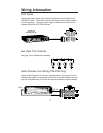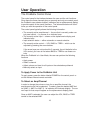
User Operation
the current input was lowered by. This is because the levels set by the user are
temporary and the ProMatrix always strives to maintain volume differences set by
the preset programming. Typically, this will only occur when the inputs or limits are
set vastly different for the inputs assigned to an amp channel. The same applies to
the tone controls where the amp tries to maintain the EQ differences.
To Select a Specific Input
The amplifier monitors active inputs and, based on the default or installer-
created priority table, automatically switches the proper input for each chan-
nel. You can override the priority switching feature to select a specific input.
1. Press the AUTO button. Its indicator LED will flash and SEL INPUT
appears on the display panel.
2. Press the desired input selector button (MIC A/B, AUX A/B/C/D). The
AUTO LED and selected input LED will flash to indicate that auto-
switching is off for this channel.
Note: You must return to auto-switching before manually selecting
another input.
Note: If one amp is manually selected but the current amp is in Auto-
switch mode, the AUTO indicator will flicker to indicate that another
channel is under manual control. When the manually selected amp is
again made current, both the AUTO and selected input LEDs will flash.
To Return to Auto Switching
Make the amplifier under manual control the current amp by pressing the
appropriate AMP button.
Press the AUTO button. The current input (based on priority) will appear on
the display and its indicator LED will light. The AUTO LED will light steady.
Important Operational Notes
When a microphone becomes active (through Vox or contact closure), the current
Aux input will be muted to a preset (Aux Mute function) level. No input switching is
allowed when the Aux mute is active.
When a higher priority input becomes active, ProMatrix changes to that input. If that
input goes silent for more that approx. 16 seconds, the unit will fade in the next
lower priority active input. (Mics in VOX mode take aprox. 4 seconds to switch back.
In contact closure mode, the switchback is immediate.) One exception is the AUX D
input which allows aprox 30 seconds of silence before switching back. This extra
delay is provided for equipment, such Juke boxes that may have a considerable
delay between music selections. If the extra delay is needed, simply give AUX D
the desired priority level for the source connected to it. If the extra delay is not
needed, leave AUX D as the lowest priority level or remove it from the priority list if it
is not needed.
21


















